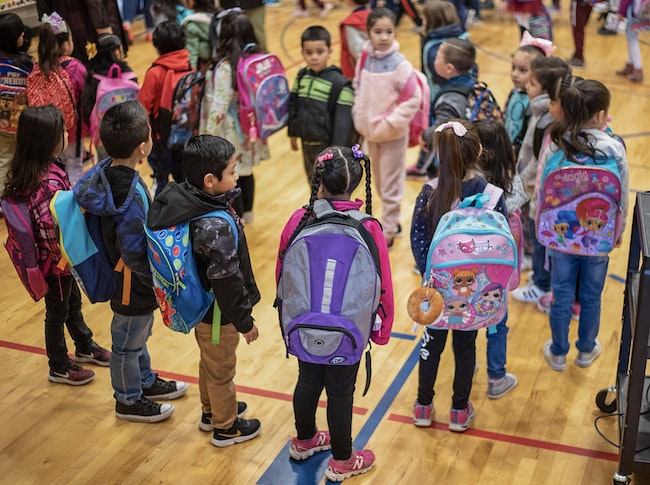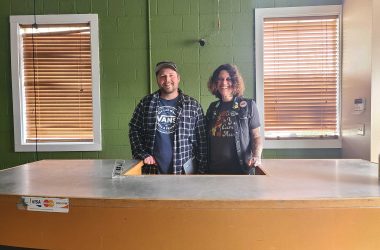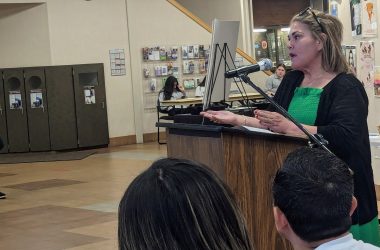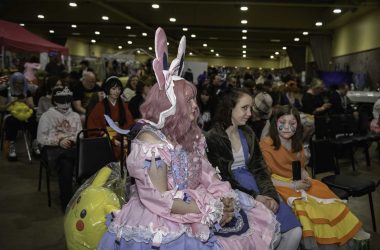
Hallman Elementary students gather during the school’s morning assembly in March 2019. (Fred Joe/Special to Salem Reporter)
In the decades he led Salem’s Catholic Community Services, Jim Seymour’s job was to help kids and families with health care, housing and other needs in the city’s poorest neighborhoods.
Some lessons stuck with him into retirement.
“Your ZIP code predicts your outcomes in life better than your genetic code,” he said.
When the agency looked at which families were seeking their help, “about 80% of them were coming from 20% of the neighborhoods,” Seymour said.
While Salem is full of effective programs that can help kids succeed in school and life against the odds, Seymour said there’s been little progress in changing those odds to close educational gaps between neighborhoods or tackle problems like homelessness.
“We never seem to get the needle to move,” he said.
Seymour is now leading an ambitious effort to help families identify and solve social problems in their own neighborhoods, backed by a team of Salem nonprofit, business and education leaders. Their vision is that “every child has a chance to grow up in a stable, nurturing home.”
The goal is to set up councils made up of parents and families who live in selected neighborhoods and support them as they identify solutions and areas where nonprofits, businesses and schools can help.
Seymour said his work at Catholic Community Services showed him that persistent problems like gang violence require solutions and leadership from the communities affected, rather than nonprofit leaders from other parts of the city telling people what’s best for them.
“The only time we ever see real results is when neighborhood residents get involved and start to make their neighborhood a better place to raise kids,” he said.
The neighborhood by neighborhood approach mirrors work Seymour led at Catholic Community Services until his 2020 retirement. The agency’s Fostering Hope program employs community health workers in specific neighborhoods who can lead workshops on health and parenting topics and help families get medical care or connect with social services.
“We’re just at a point in time where there’s a real openness, because of the commitment to racial justice and reconciliation, to share power with people that are actually being impacted by the inequities going on,” Seymour said.
The project grew out of a group, Community Business and Education Leaders, which Mountain West Investment Corporation president Larry Tokarski convened in 2019 to discuss ways to help local families.
“If we can strengthen the resilience of families in certain neighborhoods, we can then improve the lives of the children in those neighborhoods,” said Paul DeMuniz, a retired Oregon Supreme Court Justice leading the collaborative.
The group has seen some successes already. In the fall, DeMuniz said they set up a “learning hub” at the Cornerstone Apartments in northeast Salem, where many families who attend Hallman Elementary School live. There, kids can get help with their online schoolwork so they don’t fall further behind after a year without in-person classes.
Seymour’s plan to involve local families begins in the Hallman area, where a new family council has just begun meeting to discuss how best to address educational inequities.
The gaps start young. Kids entering kindergarten in Salem neighborhoods with high poverty rates, like Hallman, recognize about half as many letters and numbers as their peers in more affluent neighborhoods, according to state data.
That means more work to help those kids catch up.
“We were very excited because it’s what we want: support of families, building capacity with parents and really making sure that the resources and the supports that we offer in the schools are what they need at the time that they need it,” said Olga Cobb, an elementary school director for the Salem-Keizer School District, of the effort.
Cobb said she’s seen the same pattern in her work for the school district. In late 2019, district leaders began a series of community forums and listening sessions to gather input for how they should spend an influx of new state funding designed to close educational gaps between students.
She and other district leaders learned some programs they thought were working well, like efforts to make sure native Spanish-speaking students preserve their language abilities while also learning English, weren’t as effective as they’d thought.
“There was a lot of learning in that,” she said. “I walked away from each of those meetings with a lot of information that I don’t think we would have gotten from a survey or a family night or any of those other practices that we have done before.”
Seymour said he expects the Hallman council to be meeting regularly over the next several months. Then, the effort will expand into other high-needs neighborhoods, starting with the Auburn Elementary School area in east Salem.
His hope is for the effort to yield measurable reductions in foster care placements, absenteeism from school and other indicators of social stress.
During a mid-March meeting of the collaborative, Seymour described the group as “leaders who have chosen to follow” and said loving every child in Salem requires loving and listening to their parents.
“We’re going to be responsible for listening to anybody who wants to speak in their neighborhood,” he said.
Disclosure: Larry Tokarski, president of Mountain West Investment Company, is also a co-founder of Salem Reporter.
Contact reporter Rachel Alexander: [email protected] or 503-575-1241.
Salem Reporter counts on community support to fund vital local journalism. You can help us do more.
SUBSCRIBE: A monthly digital subscription starts at $5 a month.
GIFT: Give someone you know a subscription.
ONE-TIME PAYMENT: Contribute, knowing your support goes towards more local journalism you can trust.

Rachel Alexander is Salem Reporter’s managing editor. She joined Salem Reporter when it was founded in 2018 and covers city news, education, nonprofits and a little bit of everything else. She’s been a journalist in Oregon and Washington for a decade. Outside of work, she’s a skater and board member with Salem’s Cherry City Roller Derby and can often be found with her nose buried in a book.









